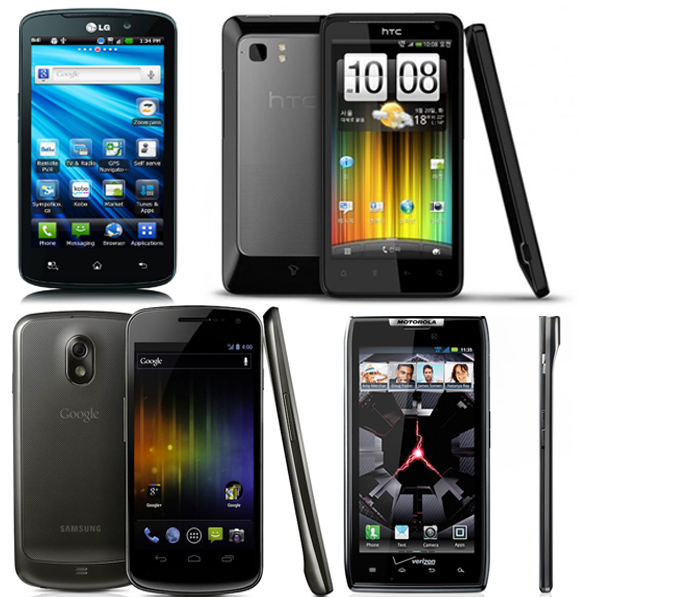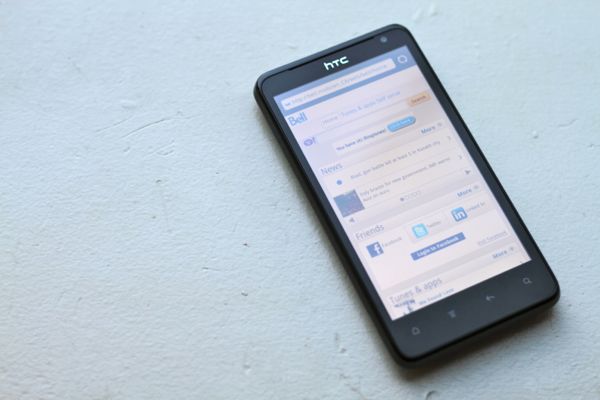 By Gadjo Cardenas Sevilla
By Gadjo Cardenas Sevilla
Smartphones today have the specs and power that desktops had only a few years ago. On the high end of the spectrum, we have the superphones which by their very definition should have dual core processors, large screens and the best functionality and are the best that money can buy.
We pit four of the most anticipated devices against each other and test them for speed, performance, design and overall capabilities. All of these are Android devices starting with the Galaxy Nexus which is Google’s chosen smartphone and the first to carry the new Ice Cream Sandwich OS.
Next we have Motorola’s revived Droid RAZR which is clad in Kevlar and incredibly sharp. The HTC Raider 4G LTE is dark, mysterious and promises blazingly fast access on next generation LTE ( Long Term Evolution) speeds of up to 75Mbps. Last but not the least is the most powerful smartphone in the market today, the LG Optimus LTE, another ultra-quick device that has more horsepower under its svelte enclosure than most of the tablets in the market today.
Google Galaxy Nexus
The Nexus name is given to only the most select of Android devices. Of all the hundreds of Google powered phones that have flooded the market only two devices have had the distinction of carrying the high mark of excellence, until now.
Just like its predecessors, the HTC Nexus One and last year’s Google Nexus S, the Galaxy Nexus was designed around the latest version of the Android OS. In this case, the most important version since Google got into the phone game. The Galaxy Nexus runs on Ice Cream Sandwich, the hybrid OS that’s designed to unify both smartphone and tablet operating systems.
Lightweight, thin and slightly contoured, the Galaxy Nexus is representative of the types of smartphones that have come to market late in the year like the Bell Optimus LTE as well as the Motorola RAZR which are similarly thin and light phones with larger screens and access to 4G or LTE high speed data connections.
The hardware is impressive with a 1.2GHz dual core processor (which is apparently a 1.5Ghz processor purposely down clocked) 1GB or RAM and a super AMOLED HD display which is more subdued and easier on the eyes. It only has a 5 megapixel camera even if this has one of the fastest startup and multiple shot features; everyone else is sporting 8 megapixels.
We pitted the Galaxy Nexus against an iPhone 4S in webpage loading using the same WiFi connection and the iPhone 4S was faster in loading pages like Maxim and Sports Illustrated by one to two seconds faster in rendering pages. This isn't bad considering that the Galaxy Nexus has a much larger screen to render.
Offering the first 4.65” HD Super AMOLED display, the screen is one of the better ones in the market but seems to have a predominantly bluish hue or tint to it; it is still an improvement over some super-saturated AMOLED screens we've seen before.
The Galaxy Nexus is an accomplished and great looking smartphone with some fantastic features, but it isn’t alone in that special place were very best smartphones rule. It has a fight on its hands with the competition it faces. While the Galaxy Nexus does have 4G, the more desirable LTE connectivity is limited to certain markets.
Read our full review of the Galaxy Nexus
Motorola RAZR
The Motorola RAZR is the thinnest smartphone in the world at only 7.1 mm thick at its thinnest point and includes a 4.3 inch Super AMOLED Advanced display, covered in a Gorilla glass screen and a woven Kevlar back plate. It is a statement of design and functionality and an entirely new product segment for Motorola which has a variety of other Android smartphones, most notably their Droid line of slide out QWERTY keyboard devices.
The RAZR is powered by an OMAP 4430 SoC (System on a Chip) with dual 1.2 GHz ARM Cortex-A9 processor cores. Its 8 megapixel rear facing camera can record 1080p HD videos. It comes with 1 GB of RAM and runs version 2.3.5 of the Android OS.
In terms of build, the RAZR is quite impressive for such a thin device. We like where Motorola is going with the exotic materials, splashproof coating and robust Gorilla Glass implementation.
The RAZR incorporates a number of unique Motorola only features like Smart Options which allows users to program the RAZR to react to certain events (i.e. plug in your headphones and it can automatically start the music app).
Motorola has also built a suite of accessories like the Lapdock which turns the RAZR into a netbook with a QWERTY keyboard and screen. As an Android device, the Motorola RAZR is very cmpetetive in features and functionalty and we quickly grew fond of its unusual look and feel. It may not be for all users and those with smaller hands might have a harder time handling its width but we think the RAZR will be a very popular device, we can't wait to see what version 2 will bring.
The HTC Raider 4G LTE

HTC has a killer year and has emerged as one of the better smartphone makers in terms of materials and features. The HTC Raider 4G LTE is their new flagship phone with LTE data capability and is replete with killer features such as a 1.2Ghz dual core processor, 1GB of RAM an eye-popping 4.5-inch qHD super LCD screen, an uncompromising 8 megapixel camera with auto focus, dual-LED flash, f/2.2, 28mm lens and a 1.3 MP front facing camera plus 720p HD video capture.
Do these specs overtake Google's own Galaxy Nexus, in a lot of areas they are evenly matched. The HTC Raider even has a higher pixel density screen, larger capacity camera and expandable memory via microSD. In terms of build, this is one of the heftier HTC smartphones we've reviewed but it does feel solid all around. A little too solid, in fact as the Raider is by far the heaviest super smartphone we've tried in the group and will definitely weigh down your pockets.
The Sense UI is evident and clearly runs the show. We think HTC's Sense is starting to show its age, while we see value in having widgets easily available, the look and feel of a lot of these could use some spiffing up. The HTC Raider 4G is fast, powerful and utilitarian and feels like a tank.
Read our full review of the HTC Raider 4G LTE
LG Optimus LTE
What LG has done by releasing the LG Optimus is set the bar Android smartphone bar really high. In some case higher in specs and features than Samsung's 'chosen' Galaxy Nexus which is the flagship Android device of the season sporting the new Android 4.0 Ice Cream Sandwich.
Visually unassuming, the LG Optimus is surprisingly thin and light for a smartphone of this pedigree. It brings a dual-core 1.5 GHz processor, 1GB of RAM and an HD display which is stunning to behold. The Optimus LG also features an 8 Megapixel camera as well as the ability to shoot 1080p HD videos.
This smartphone has better specs than most tablets in the market right now and tells us just how serious LG is in claiming the top spot in the high-end Android smartphone space.
The LG Optimus is comparable to the Moto RAZR as well as the Galaxy Nexus and even has an advantage over these two high end Androids because it is rated to use fast LTE network (They do 4G speeds at 14Mbps (RAZR) and 21Mbps (Galaxy Nexus), the Optimus can theoretically reach 75 Mbps which is close to high-end broadband speeds. Our real world tests wavered between 15-23 Mbps.
The Optimus LTE is also the most perfectly balanced device. The design is not too daring or aggressive but it feels good in the hand and not too light in weight, a problem we had with both the RAZR and the Galaxy Nexus. We think LG is headed in the right direction with the Optimus LTE.
Read our full review of the Optimus LTE
Conclusion
There are so many excellent Android superphones coming to the market today that users interested in Android are going to have a hard time choosing what works best. We’ve gotten to the point that the Google hero device is no longer the runaway winner.
Sure, the Galaxy Nexus has a phenomenal screen, runs Ice Cream Sandwich natively and is incredibly thin and light and Samsung fans will definitely want it since it is the evolutionary successor to the Nexus S. It isn't all that different from the Samsung Galaxy S II 4G, however and as a result may be less compelling than the Nexus S was a year ago. It is still a stunning device and ICS is a good update with some solid, useful and user friendly features.
Motorola’s RAZR is a solid all-around device, thinner than the Galaxy Nexus and just as powerful and it has all those add-ons like the lapdock which might attract some users. We think it is a bit overdesigned and are worried that the battery life will be an issue.
HTC’s Raider is a strong contender for the top spot. It is all business and feels really robust but it is heavy.
The one device that really surprised us and which convincingly hit all the sweet spots is the LG Optimus LTE. It feels great in the hand, has truly useful features and will run Ice Cream Sandwich well once that becomes available.
The LG Optimus LTE is the best 4G Android superphone we’ve tested to date and the one that sneaks past the other three in specs, 4G speeds and all around features in this shootout.